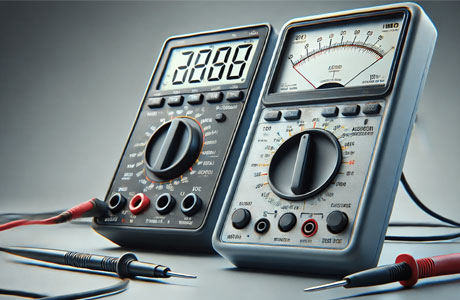What Is The Main Function Of A Multimeter?
Key Takeaway
The main function of a multimeter is to measure electrical properties such as voltage, current, and resistance in circuits and devices. It helps identify issues like broken connections, faulty components, or incorrect voltage levels. A multimeter is essential for diagnosing and maintaining electrical systems accurately and efficiently.
Multimeters can be either analog or digital, with digital multimeters being more common for their precision and ease of use. They are used in a wide range of applications, from testing household wiring and batteries to troubleshooting complex electronics. This versatility makes the multimeter an indispensable tool for professionals and DIY enthusiasts alike.
Measuring Voltage: AC and DC Applications
The most fundamental use of a multimeter is measuring voltage. Whether you’re working with household circuits, automotive systems, or industrial equipment, understanding voltage levels is critical for safety and functionality.
To measure DC voltage, such as that in batteries or power supplies, you simply set the multimeter to the DC voltage mode and connect the probes to the circuit’s positive and negative points. The reading tells you whether the voltage is within the expected range.
For AC voltage, common in outlets and appliances, the process is similar. Set the multimeter to AC mode, and the reading will indicate the voltage amplitude. This is particularly useful for checking if an outlet is delivering the correct voltage, typically 110-240 volts depending on your region.
Accurate voltage measurements are essential for identifying power supply issues or confirming safe operating conditions. Multimeters provide quick and reliable results, making them invaluable for electricians and engineers alike.

AC and DC Applications H2: Testing Current: Direct and Indirect Methods
Current measurement is another core function of a multimeter. It helps identify how much electricity flows through a circuit, which is critical for diagnosing overloaded circuits or faulty components.
Direct measurement involves connecting the multimeter in series with the circuit. This method allows the entire current to pass through the device, providing an accurate reading. However, care must be taken to select the appropriate range to avoid damaging the multimeter.
For higher currents, clamp meters, a type of multimeter, use an indirect method. They measure current without breaking the circuit by clamping around a conductor. This is safer and more convenient, especially in high-voltage environments or for live circuits.
Understanding current flow is crucial for tasks like motor troubleshooting, battery testing, or ensuring compliance with design specifications. With the right multimeter, these measurements become straightforward and reliable.
Testing Current: Direct and Indirect Methods H2: Resistance Measurement: Identifying Open Circuits and Short Circuits
Resistance measurement is vital for troubleshooting electrical circuits, and a multimeter excels in this area. By applying a small current and measuring the resulting voltage drop, the device calculates the resistance using Ohm’s Law.
This function is especially useful for locating open circuits, where the flow of electricity is interrupted. By testing various points along a wire or circuit, you can pinpoint where the break occurs.
Similarly, it helps identify short circuits, which occur when two points in a circuit connect unintentionally, causing excessive current flow. The multimeter will show a very low or zero resistance reading in such cases, alerting you to the issue.
Resistance measurement is not only important for diagnosing faults but also for verifying component values during circuit design or repair. For engineers and technicians, it’s a straightforward yet powerful feature that enhances accuracy and efficiency in troubleshooting.
Direct and Indirect Methods H2: Resistance Measurement: Identifying Open Circuits and Short Circuits H2: Specialized Functions: Continuity Testing and Diode Checking
Continuity testing is one of the most user-friendly features of a multimeter. It helps determine if there’s a continuous electrical path between two points. When continuity exists, the multimeter often emits a beep, making it easy to confirm connections without looking at the display. This function is especially helpful for checking fuses, cables, and circuit traces.
Diode testing is another specialized function. Diodes are components that allow current to flow in one direction only, and their proper functioning is essential in many circuits. A multimeter can test diodes by applying a small voltage and measuring the forward voltage drop. This ensures the diode is not damaged and operates as intended.
These specialized functions add versatility to the multimeter, making it more than just a measuring device. They simplify diagnostics and save time, especially for professionals working in maintenance, repair, or prototyping.
Resistance Measurement: Identifying Open Circuits and Short Circuits H2: Specialized Functions: Continuity Testing and Diode Checking H2: Advanced Features in Modern Multimeters: Capacitance, Frequency, and More
Modern multimeters go beyond the basics, offering advanced features that expand their functionality. Capacitance measurement is a key addition, enabling users to test capacitors in electronic circuits. By measuring the charge a capacitor can hold, this function helps identify faulty components in power supplies or motor control circuits.
Frequency measurement is another valuable feature, particularly in systems involving alternating current or oscillating signals. It allows engineers to verify that components like inverters or signal generators operate at the correct frequency.
Other advanced features include temperature measurement, where a thermocouple attachment lets the multimeter monitor heat levels, and data logging, which records measurements over time for detailed analysis.
These features turn the multimeter into a comprehensive diagnostic tool, capable of addressing complex challenges in modern electrical and electronic systems. They demonstrate how far this versatile device has evolved to meet the needs of professionals across industries.
Conclusion
A multimeter’s main function is to measure electrical parameters, but its diverse capabilities make it an indispensable tool for electrical and electronic tasks. From measuring voltage and current to testing resistance and utilizing advanced features, this device empowers engineers and technicians to work with confidence and precision.
Understanding how to leverage a multimeter’s functionalities not only enhances efficiency but also ensures safety in diagnostics and repairs. It’s a tool that bridges the gap between theory and practice, proving its worth in every application, from simple household fixes to complex industrial systems.

